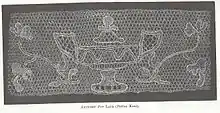Antwerp lace
Antwerp lace is a bobbin lace distinguished by stylized flower pot motifs on a six point star ground. It originated in Antwerp, where in the 17th century an estimated 50% of the population of Antwerp was involved in lace making. Antwerp lace is also known, from its familiar repeated motif, as Pot Lace— in Dutch Pottenkant or Potten Kant.[1][2] It is sometimes said that the flowers were a depiction of the Annunciation lilies;[2] however, the flowers were not limited to lilies.[3]

It is a continuous lace, meaning that it was made in one piece on a lace pillow, using the same threads in the pattern as in the ground, or réseau.[4][5] Antwerp lace is very similar to Mechlin lace, which was also made in Antwerp. Antwerp lace is heavier and sturdier than Mechlin lace.[1] It has a cordonnet, or a flat thread outlining the pattern, just as Mechlin lace does. The cordonnet was very strong and rather coarse.[3] Antwerp lace was also similar to Binche lace in its cordonnet.[2] The réseau or ground for Antwerp lace varies from the same hexagonal ground as Mechlin lace to a tessellation-pattern featuring a six-pointed star.
History
Antwerp lace was being made during the 16th century. When the Dutch closed the river Scheldt to shipping in 1585 due to Antwerp falling under Spanish control, the production of Antwerp lace halted.[6] By 1698 Antwerp lace was known in England.[7] It first became popular as an export to the Spanish Indies, however when that market died the lace survived in traditional dress among the peasants near Antwerp. It was used mainly for trimming their hats throughout the 18th and 19th century.[1]
References
- Earnshaw, Pat (February 1999). A Dictionary of Lace. Dover Publications. p. 6. ISBN 0-486-40482-X. Retrieved 2008-05-20.
- Blum, Clara (June 2002). Old World Lace: A Concise Illustrated Guide. Dover. pp. 37–39. ISBN 0-486-42150-3. Retrieved 2008-05-20.
- "Mechlin and Antwerp" (PDF). Archived from the original (PDF) on 2004-02-25. Retrieved 2005-06-13.
- Sharp, Mary (March 2007). Point and Pillow Lace. Herron Press. p. 147. ISBN 978-1-4067-4562-7. Retrieved 2008-05-20.
- Earnshaw, Pat (February 1999). A Dictionary of Lace. Dover Publications. p. 13. ISBN 0-486-40482-X. Retrieved 2008-05-20.
- Deboeck, Guido (2007). Flemish DNA & Ancestry: History of Three Families Over. Dokus Publishing. p. 69. ISBN 978-0-9725526-7-7. Retrieved 2008-05-24.
- Palliser, Bury (November 1984). History of Lace. Dover Publications. pp. 115–116. ISBN 0-486-24742-2. Retrieved 2008-05-20.
antwerp lace.
